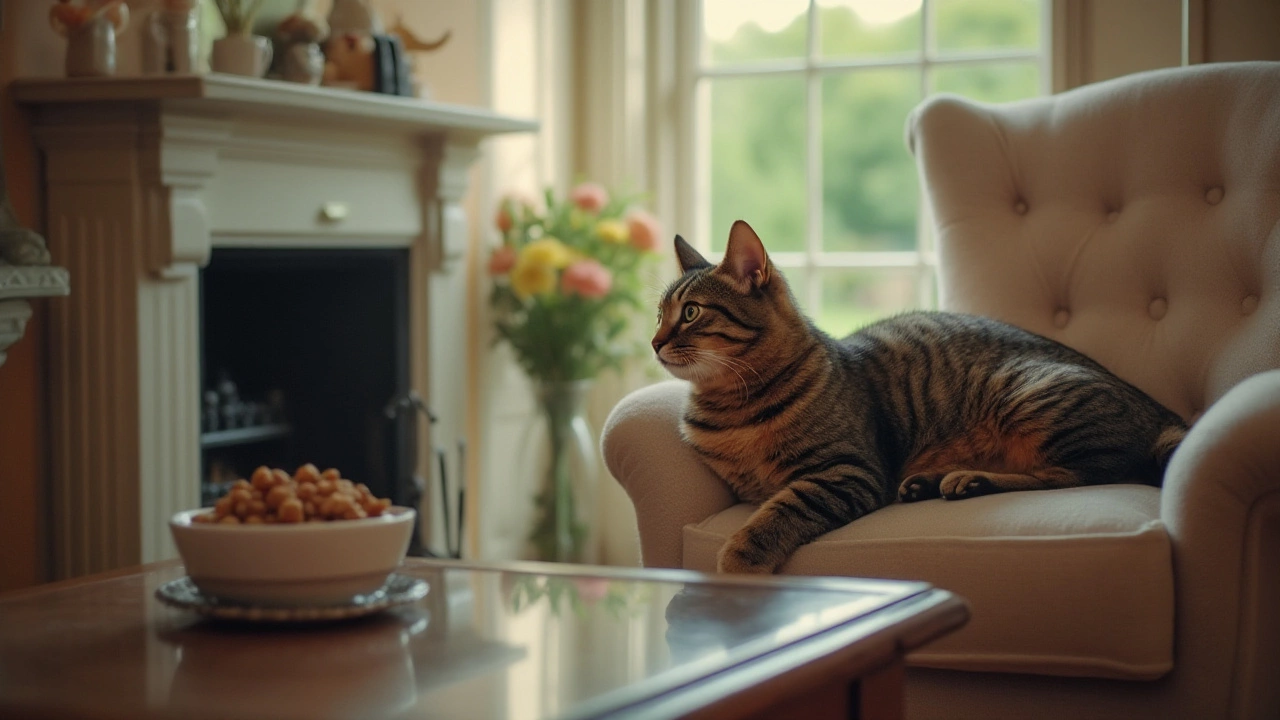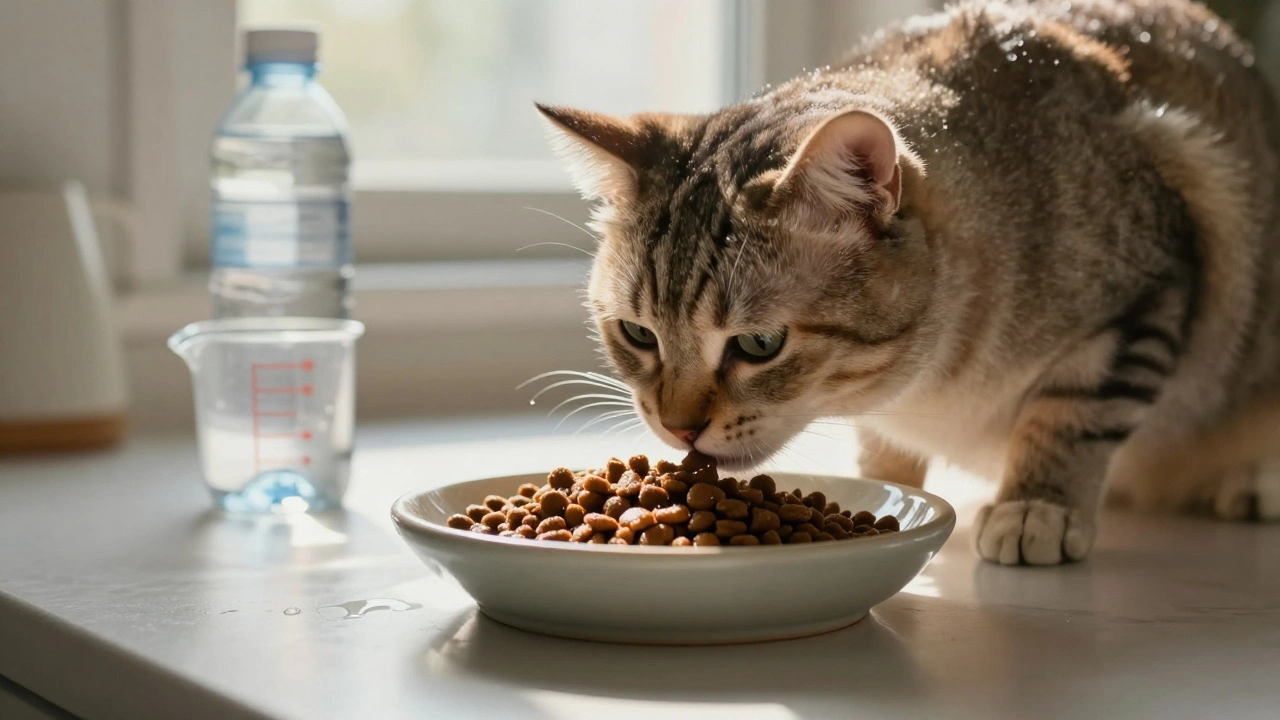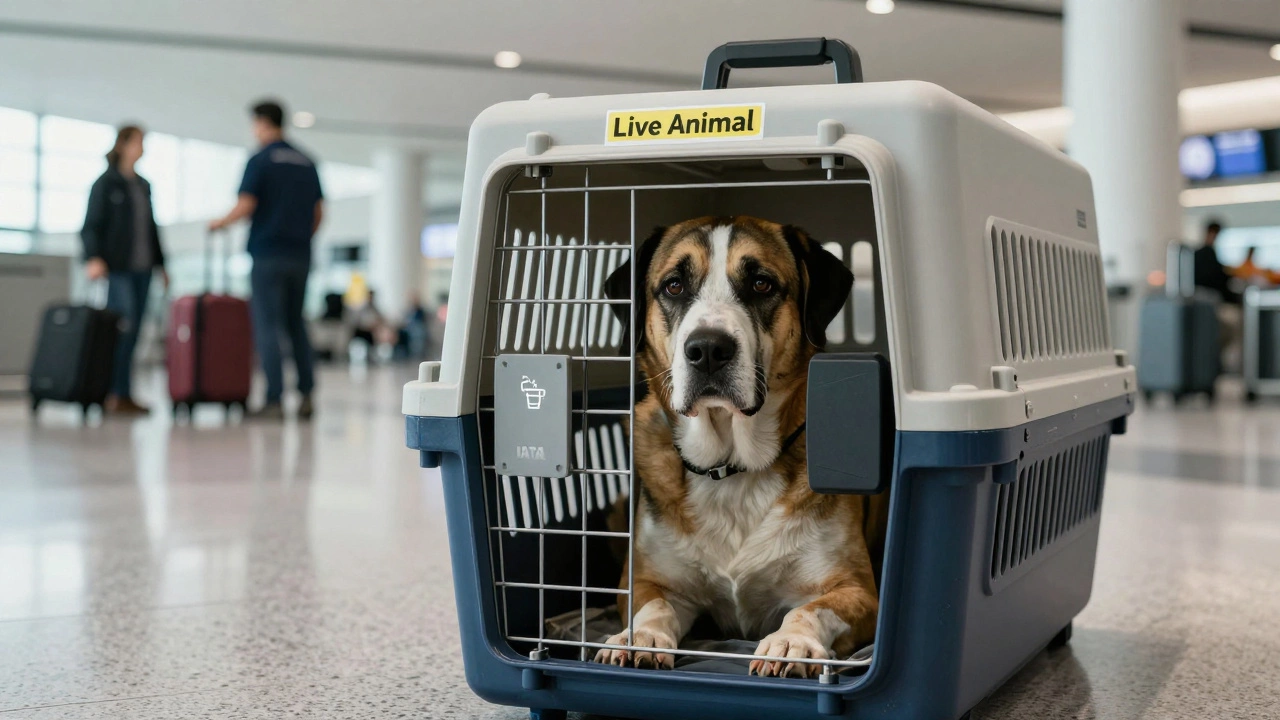Cats have a knack for capturing our curiosity with their mysterious yet endearing behaviors. When it comes to feeding, cat owners often face the choice of letting their feline friends nibble on food throughout the day or sticking to scheduled meal times. It’s a debate that intertwines natural instincts with modern pet care.
In understanding the dynamics of cat feeding, one must first consider the natural inclinations of these graceful creatures. Cats in the wild are known for their agile hunting skills, which ensure they eat several small meals a day. Translating this to a home setting, free-feeding might seem like a fitting mimicry of natural habits. But, is it the best approach for your indoor cat?
Join us as we unravel the intricacies of free-feeding, examining both its advantages and possible pitfalls. Armed with practical tips and scientific understanding, you’ll be better prepared to decide if all-day food access is a feast or a faux pas for your feline companion.
- Understanding a Cat's Natural Feeding Habits
- Benefits of Free-Feeding for Cats
- Potential Drawbacks of Unlimited Food Access
- Balancing Nutrition with Feeding Schedules
- Tips for Healthy Feeding Practices
- Choosing the Right Approach for Your Cat
Understanding a Cat's Natural Feeding Habits
Cats, wild or domestic, are obligate carnivores, which means their diet primarily consists of meat. This dietary nature stems from their ancestors, who roamed the arid landscapes and hunted small animals such as birds and rodents. This data on their ancestral feeding patterns highlights a lifestyle characterized by consuming multiple small meals across the day, whenever prey was available. It’s part of their very essence, guided by an innate drive to hunt, nibble, and maintain steady energy levels throughout their waking hours. Hunting and consuming their prey in short bursts allows them not only to manage their energy efficiently but also to fine-tune their predatory skills, tracing a line back to their wild roots.
In a domestic setting, cats retain some of these instinctual behaviors. Observant pet owners often notice their cats exhibit periods of intense activity followed by long hours of rest – a reflection of the quintessential hunter's cycle. It’s interesting to note that, as per statistics, 60% of pet cats exhibit this behavior of activity cresting at dawn and dusk. Mimicking such natural habits in a home environment may involve providing opportunities for both play and feeding that align with these instinctual cues.
Moreover, cats have individualized feeding habits. Some felines prefer frequent small meals, mimicking their wild counterparts. Others may enjoy the security of a constant food supply to graze at leisure. This variation in dietary behavior is crucial when considering how best to feed your furry friend. Each choice concerning feeding should ideally echo their inherent tendencies while ensuring they receive the necessary nutrients essential for health and vitality. This balance requires a nuanced understanding of both the feline's ancestral habits and their domestic lifestyle.
Dr. Jane Bicks, a renowned veterinary nutritionist, once mentioned, "Understanding your cat's history and instincts spawns a respect and awareness of how we should approach feeding them in the modern world." Her insights echo the need to harmonize ancestral knowledge with contemporary practices.
Recognizing these aspects of a cat's nature not only empowers pet owners to meet their companions' nutritional needs but also enriches the bonding experience. When viewed through the lens of natural habits, feeding becomes an act less mechanical and more in tune with the cat's old-world charm. For modern cat owners, the challenge is finding that sweet spot between nurturing a creature of instinct and catering to the accustomed comforts of indoors.
Benefits of Free-Feeding for Cats
Allowing your cat limitless access to food can initially seem like an appealing choice for pet owners who value convenience and wish to accommodate their cat's natural predatory instincts. In the wild, our feline friends are known to eat plenty of little meals as they catch various prey throughout the day. By free-feeding at home, owners can mimic these natural habits, ensuring their cats have the flexibility to follow their instincts and eat when hunger strikes. This method can also relieve stress for those cats who may become anxious if food is not available at their every whim. In this environment, cats are at liberty to self-regulate their dietary intake, which could potentially reduce disruptive behaviors linked to hunger.
For multi-cat households, free-feeding can also ease the social dynamics, as feeding time can sometimes be a source of tension among cats. Instead of competing for meals, free-feeding ensures every cat has access to nourishment without the need for fuss or fights. The unstructured feeding schedule allows them to eat without the pressure of time, making interactions around the food bowl much calmer. Supporters claim this approach creates a harmonious home for both the cats and their human caretakers.
A significant advantage of free-feeding is the convenience it offers. Pet owners with demanding schedules or those who travel frequently find this strategy beneficial since it eliminates the need for strict mealtime routines. Food can be left out before leaving the house, reducing worry over the cat's well-being during busy workdays. Plenty of pet owners, especially those who work long hours, find this approach aligns better with their lifestyles.
According to Dr. Jane Smith, a renowned feline nutritionist, "While structured meals are beneficial, allowing cats the liberty to access food on-demand often results in happier, less stressed animals."
It is crucial to note, however, that free-feeding requires attention to the quality of food provided. Choosing the right type of kibble or dry food is imperative, as not all cat foods are created equal. Owners should ensure they're providing high-protein, low-carbohydrate options to support their cat's dietary needs without contributing to unwanted weight gain. Observing your cat's eating patterns and consulting with a vet can verify that they are getting appropriate nutrition. In doing so, free-feeding can become a beneficial and manageable part of your cat's care routine.
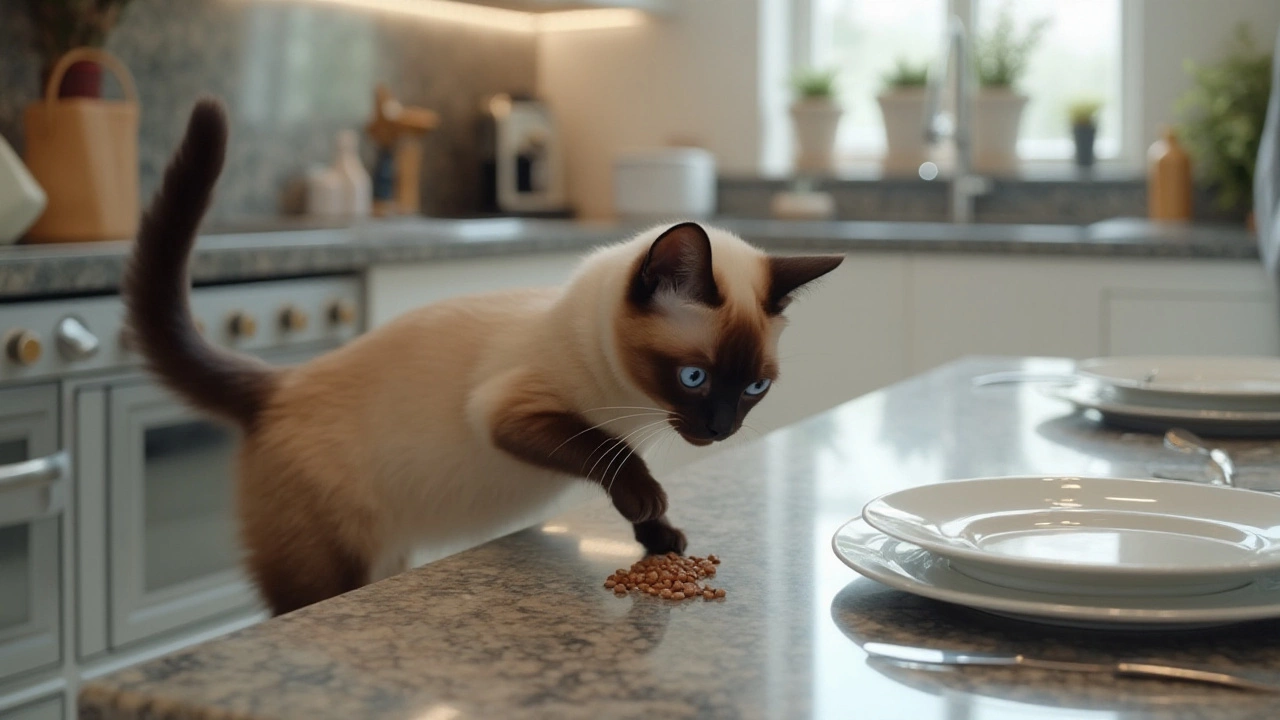
Potential Drawbacks of Unlimited Food Access
While the notion of letting your cat graze on food all day might seem like a gateway to feline paradise, it brings along a fair share of challenges. One of the most significant concerns is the risk of obesity. Cats, much like people, aren't always the best judges of how much is too much when it comes to eating. Offering unlimited food access can lead to excessive calorie intake, especially if the food is calorie-dense. With obesity comes the increased risk of a host of health issues such as diabetes, arthritis, and heart complications, which can significantly affect your cat’s quality of life and longevity.
Beyond weight concerns, free-feeding can disguise other problems. If a cat is ill or stressed, their appetite may decrease, but with a perpetually full bowl, it can be easy to overlook a lack of eating as a symptom. This could delay necessary vet visits and interventions, leading to an escalation of any underlying issues. Additionally, leaving food out all day long can sometimes affect the freshness of the food, particularly with wet food options. Stale or spoiled food can deter cats from eating properly, or worse, lead to gastrointestinal problems if consumed.
There’s also the matter of behavior and interaction. Mealtime provides crucial opportunities for enriching your pet’s environment and fostering a strong bond between you and your feline friend. Scheduled meals can encourage play and active engagement, while free-feeding can result in cats showing less interest in their surroundings and less motivation for play, as they no longer associate meals with a time for attention or activity. Pet nutrition experts often suggest that scheduled feeding can stimulate a more natural rhythm and offer psychological well-being by mimicking hunting routines.
Finally, though food access might be uniform in a multi-cat household, individual feeding habits can vary widely. More aggressive or dominant cats might monopolize access to the food, preventing shyer ones from getting their fair share or timing. This can lead to uneven weight distribution, with some cats gaining weight while others might lose it, even when all cats have identical food access. Establishing a balance becomes crucial in such scenarios.
"Pet owners need to be mindful of the impact that continuous feeding can have on their pet's health and behavior. It's about finding that sweet spot between nourishment and nurture," advises renowned veterinarian Dr. Lynn Laurence.
Despite these potential drawbacks, free-feeding may still work for certain households under careful observation. Those with hectic schedules might find it a practical choice, but it should always be weighed with thoughtful monitoring and nutritional understanding. Watching your cat’s weight, behavior, and health will help you decide whether this approach suits them or if modifications to their cat feeding routine might be necessary. Regular veterinary check-ups play a vital role in ensuring the chosen feeding method aligns with the overall health objective for your beloved pet.
Balancing Nutrition with Feeding Schedules
Balancing nutrition with feeding schedules often leaves cat owners caught between a rock and a hard place. On one hand, cats have a natural propensity for consuming multiple small meals throughout the day, reminiscent of their wild ancestors who would eat as they caught prey. On the other hand, structured feeding times have become the norm in many households, offering an element of control over what and how much our furry companions eat. Understanding how to find the middle ground requires a closer look into a cat's dietary needs and the benefits of structured eating patterns. A balanced feeding schedule is not just about the time food is offered; it's about the nutritional value of each nibble. Cats are obligate carnivores, meaning they rely on nutrients primarily found in animal tissues. This contrasts with many other household pets that may have omnivorous tendencies, allowing for greater dietary flexibility. Cat food, whether dry kibble or canned, should therefore be rich in protein and fat, with minimal carbohydrates. Maintaining awareness of these nutritional components is essential when establishing a feeding routine.
Implementing a feeding schedule requires considering both the quantity and quality of cat food provided. Measuring portions can help prevent overfeeding, which impacts a cat’s health over time, leading to obesity—a common issue for indoor pets. Scheduled feeding also allows for better observation of a cat's eating behavior. If a typically ravenous eater begins to shy away from the bowl, it may signal underlying health concerns. This type of monitoring is less achievable with free-feeding, where food intake can be sporadic and less apparent.
"A structured feeding schedule can serve as an early detection system for health issues," says Dr. Jane Robertson, a feline nutrition specialist. "Observing a cat's eating habits closely is crucial for spotting changes that may indicate illness or distress."
Recent studies underscore the benefits of feeding schedules that respect a cat's natural inclinations while balancing them with structured routines. For instance, maintaining consistent feeding times can help regulate a cat's digestive health and ensure better metabolic functioning. Cats are creatures of habit, and consistency offers emotional comfort and stability in their environment. Varying the schedule unnecessarily or pairing it with sudden changes in diet can disrupt digestive systems, leading to unpredictable stool patterns or even stress-induced behaviors.
For those who opt to blend free-feeding with scheduled meals, there’s a happy medium that caters to both nutrition and the desire for autonomy. Providing set meals while leaving a small amount of dry kibble available throughout the day can cater to a cat’s grazing instincts without neglecting nutritional needs. It's a practice that should be undertaken with care, keeping an eye on weight management and ensuring excess intake doesn’t become the norm. Owners should evaluate the chosen method's success through regular weigh-ins and periodic veterinary check-ups, allowing adjustments as a cat's lifestyle or activity level evolves.
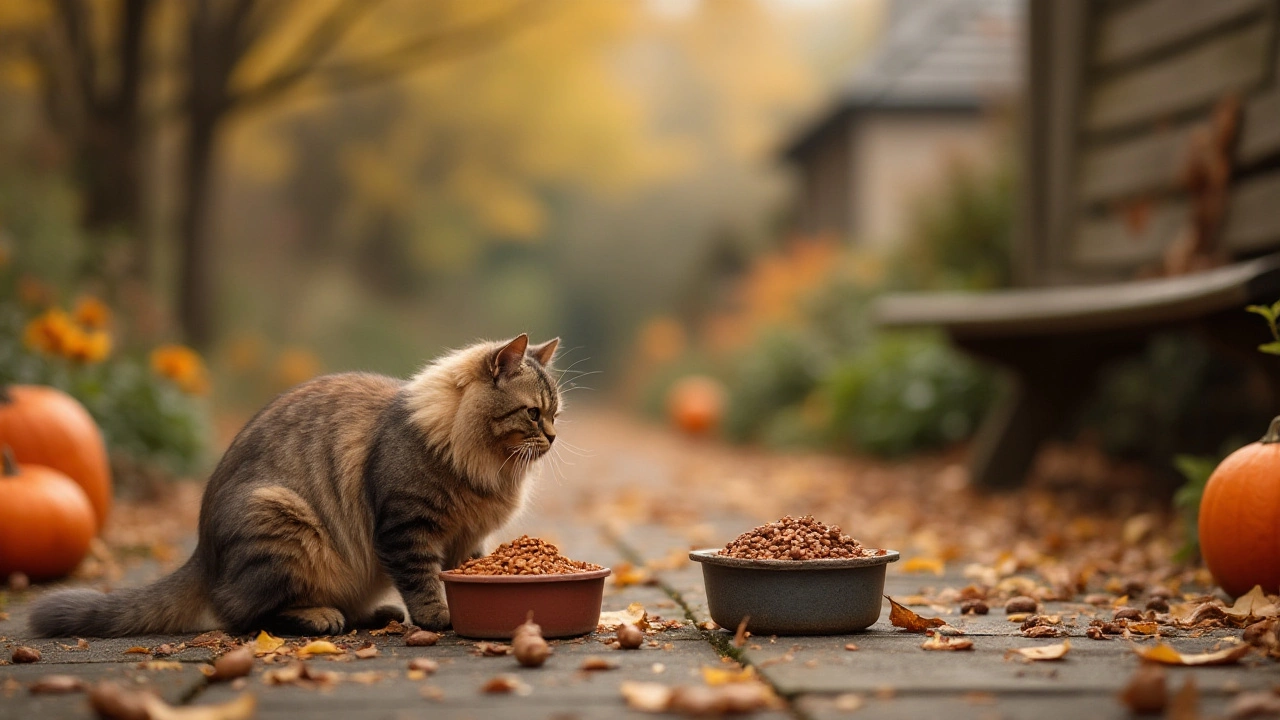
Tips for Healthy Feeding Practices
Navigating the myriad options for feeding your feline companion can seem overwhelming. However, maintaining healthy cat feeding habits doesn’t have to be a mystery. One essential tip involves understanding the nutritional content of what you're offering. Cats are obligate carnivores, meaning their diet must include meat to meet their nutritional requirements. Ensuring high-quality, protein-rich meals is vital for their health. Always check the ingredient list on cat food labels, looking for animal-based ingredients as the primary source. Avoid foods high in carbs, which can lead to weight gain and other health issues. Experiment with different brands and flavors to identify the ones most suitable for your cat’s palate and health.
Portion control is a fundamental aspect of cat health. While free-feeding allows your pet to graze, it’s critical to monitor their overall intake to avoid obesity. Weigh your cat regularly, and if you notice an increase in weight, consider scheduled feeding times rather than continuous access. Implementing meals twice a day can help maintain a healthy weight. Additionally, using a digital feeder can assist in portioning out the perfect meal size, providing timed meals even when you’re not home.
Establishing a consistent feeding routine greatly benefits both owner and pet, promoting a sense of security and routine. Aim to serve meals at the same times each day, which trains your feline companion’s body clock to anticipate when food is coming. This can reduce anxiety and prevent unnecessary overeating during meal times. Create a peaceful dining environment by choosing a quiet, comfortable spot away from distractions or competition with other pets.
“Feeding cats isn't just about filling their bowls. It’s about providing the right balance of nutrients, understanding their unique needs, and ensuring every meal contributes to their well-being,” says Dr. Jane Doe, a veterinarian specializing in pet nutrition.
Inquiring about your vet’s recommended pet nutrition plan can provide valuable insights. They can offer tailored advice based on your cat’s age, activity level, and health conditions. Young, active cats may need more calories than older, less active ones. It’s beneficial to adapt the feeding strategy over time, aligning with their changing life stages and energy demands. Mixing wet and dry food also offers variety while preventing dehydration, common in cats with low water intake. To track consumption habits, maintain a food diary noting any changes in eating behavior, important for identifying health issues early.
Interactive feeding using toys or puzzle feeders can also enrich your pet’s daily routine. This approach mimics the hunting behavior innate in cats, providing both mental stimulation and physical exercise. Studies reveal that such interactive methods can help reduce behavioral issues associated with boredom and under-stimulation.
Choosing the Right Approach for Your Cat
Picking the right feeding strategy for your cat isn't just about convenience; it's about fostering their well-being and happiness. Every cat is unique, and what works for one might not suit another. To make the best decision, consider a variety of factors including your cat's age, activity level, and any health issues. Kittens, for instance, require more frequent meals due to their rapid growth patterns—a need distinctly different from their adult counterparts. On the other hand, older cats might benefit from a regulated feeding schedule to manage weight and ensure proper nutrition.
An important step is to observe your cat's behavior. Is your pet a natural grazer, nibbling small amounts throughout the day, or do they devour their food in one sitting? This can provide insights into the kind of feeding approach that might suit them best. While free-feeding can minimize food anxiety for some cats by ensuring they're never truly hungry, it might lead to overeating and subsequent health issues like obesity in others. A report by the Association for Pet Obesity Prevention highlights that approximately 60% of cats in the U.S. are classified as overweight or obese, illustrating the careful navigation needed in feeding practices.
Whether you choose scheduled meals or free-feeding, consistency is key. Cats thrive on routine, so provide meals at the same time each day if you're opting for scheduled feeding, or ensure that fresh food is regularly available if they prefer grazing. It's also vital to select high-quality cat food that caters to their nutritional needs. Reading the ingredients and focusing on protein-rich diets mimicking the prey cats would eat in the wild is crucial. An approach that emphasizes balanced nutrition will promote a healthier life for your feline friend.
Dr. Jane Doe, a feline nutrition specialist at CatCare Clinic, states, "Understanding your cat's individual dietary requirements is essential. What one cat thrives on might not work for another, so it's important to tailor your feeding approach to your cat’s specific needs."
Don't forget to monitor your cat's weight and overall health regularly. Frequent check-ups with your veterinarian can provide clarity on whether adjustments in their diet are necessary. They can offer guidance tailored to your cat's health profile, making sure that your beloved pet gets an optimal balance of nutrients. Keeping abreast of the latest research on pet nutrition facilitates better decisions, ensuring your cat leads a long, vibrant life.
To sum up, the journey of selecting the right cat feeding method is nuanced and involves trial and error. Whether you pick free-feeding, scheduled meals, or a combination of both, remaining observant and open to adapting your approach will significantly contribute to your cat's overall well-being. By prioritizing their unique needs, you're not just feeding your pet; you're nurturing a cherished member of your family.

